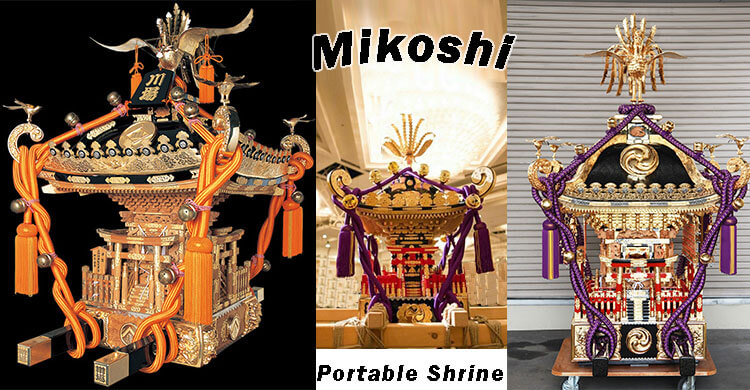Bearing a “Mikoshi (Portable Shrine)” on our shoulder on festival day , you can’t beat it when it comes to dispelling accumlated stresses and having big fun.
This is not an exaggerated to say that these events are in a way noisy and boisterous and bacchanalian revelry at the first glance.
That’s because we start drinking Sake in the morning and carring heavy heavy portable shrine on our shoulder and shouting cheerfully “Wasshoi, Wasshoi” or “say ya, soi ya, sah, sorya” or “Dokkoi Dokkoi” etc,. under being fairly tipsy.
Hello everyone, how is it going?
Following Matsuri (festival) which I posted yesterday, today’s topic is Mikoshi (portable Shinto shrine) that is the necessity in Matsuri, from which you can understand deeply what’s it like through the website Matsuri .
Contents
Why Sake is so important in Matsuri?
Besides the Mikoshi, Sake is one of indispensable parts of Matsuri since sake has long been an important offering to Shinto deities, the Kami (deity), who clearly like sake very much.
The sake once offered to the kami is called “Omiki“, and it’s believed to aquire divine powers and to be very auspicious That’s why sake is strongly connected with Matsuri.
And hearing god loves Sake, how pleasant sound to our ears, sake-lovers.
What’s Mikoshi (Portable Shrine)?
The Mikoshi, (portable shrine) which is brought out from the main shrine building and paraded through the city streets.
The deity of the shrine is believed to enter the mikoshi, which the local people carry from place to place around the neighbourhood.
Because deities are usually shut away deep inside shirines, annual mikoshi parades like this are a rare chance for the local people to get close to them.
In ancient times, the emperors and aristocrats in Kyoto would ride in palanquins called koshi. For the palanquins used to carry the deities, mi, the Japanese word for “god”, was added, making the word mikoshi.
Gradually, this practice of carrying the deities around local neighbourhoods spread throughout the country.

Mikoshi are very heavy and can weigh over a ton so carrying them is considered a big challenge

A mikoshi is composed of three main sections. First is the central chamber. This is where the deity resides during festivals, so it’s the most important component of the mikoshi.
A small torii shirine gate is usually placed next to the chamber.
Torii are erected at the entrances to shrines to symbolize that the ground inside is sacred. The central chamber of the mikoshi represents the shrine itself.
A roof is place on top of the chamber. The tops of most mikoshi roofs are decorated with a phoenix, which is believed to be highly auspicious.
According to legend, the appearance of a phoenix heralds the birth of a great ruler.
The main structure and roof are supported on a base fitted with poles, so that the mikoshi can be carried around. Ther bearers support the poles on their shoulders.
In some festivals, they jog the mikoshi up and down as they carry it. This movement is believed to stimulate the deity inside, heightening its powers.
Transferring the deities into mikoshi and parading them around the streets. This is the way Japanese people deepen the connection with their local deities.
A festival is an event ordinarily celebrated by a community and centering on some characteristic aspect of that community and its religion or traditions.
It is often marked as a local or national holiday. Next to religion and folklore, a significant origin is agricultural.
Food is such a vital resource that many festivals are associated with harvest time. Religious commemoration and thanksgiving for good harvests are blended in events that take place in autumn.
You probably get an impression from watching their parade that sometimes the participants almost seem to be fighting each other, and it’s more fun than a game of rugby!

Mikoshi fighting on Nada-no-Kenka (fighting) Matsuri at Himeji
Is the Nada no Kenka Matsuri (Nada Fight Festival) really about fighting?
It’s not about people fighting with each other.
It’s said that the festival got its name “Kenka” (fighting) because of the intense collisions where the portable shrines (mikoshi) dedicated to the gods are vigorously struck against each other to the point of damage, resembling a contest of strength between giants.
Not only the portable shrines but also the participants carrying them and those around them enthusiastically collide, leading to many injuries. There’s a saying, “Injuries and lunch boxes are your own responsibility,” emphasizing personal responsibility for injuries.
This autumn festival takes place on October 14th and 15th every year at Matsubara Hachiman Shrine in Shirahama-cho, Himeji City.
Also known as the Kenka Matsuri of Nada, it involves the spirited collision of portable shrines, with roofs being chipped away and decorations flying off.
The more intense the collisions, the more it is believed to fulfill the will of the gods.
Due to its unique and special nature, it’s considered one of the extraordinary festivals in the world.
Why do the men wear loincloths?
In the Nada Kenka Matsuri and other autumn festivals across various regions, the tradition has been for women to refrain from participating, while men take part to carry out the festivities.
Among the participants, those who bear the heavy floats need to support their lower backs, and they wear a garment called “mawashi” rather than a loincloth.
What’s the long poles held by people around the floats
These long poles are generally referred to as “shide.” They are held by individuals near the floats and are used to guide the direction of movement for the float carriers, add to the excitement by waving them in time with chants, and enhance the festivity.
Each village has its own distinctive color for the shide. The sight of numerous shide being shaken up and down as the float progresses is akin to a ship navigating through rough waves, making it a spectacle worth seeing.
Now let’s see a vigorous fight festival.













